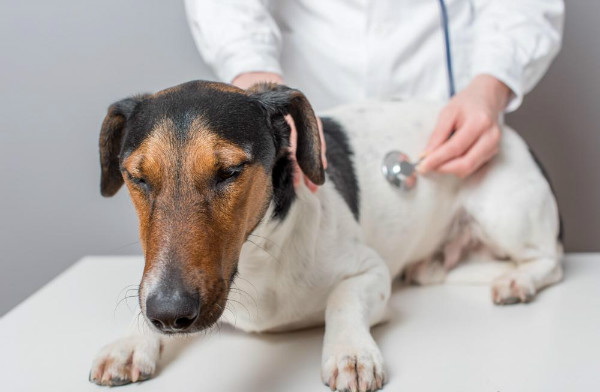An experienced dog owner, let alone a breeder, knows which the dog’s temperature must be familiar with its process measurements. However, a novice or owner whose dog never I didn’t get sick before, this moment can cause a lot of questions: starting on in which case indicators are the norm, and which signs accompanied by a decrease or increase. How to understand that the dog has a temperature, and how can I confirm my guesses?
Content
- 1. Signs of lowering and fever in the dog
- 2. Dry nose – a sign of high fever
- 3. The condition of the mucous membranes
- 4. Condition of the dog’s armpits
- 5. Lowering body temperature: how to identify and what is dangerous
- 6. Why is the pet trembling
- 7. Primary symptoms of high fever
- 8. Common reasons for rising and lowering temperature
- 9. High temperature: what to do to the owner
- 10. Watch the video how to measure the temperature in animals
- 11. Temperature measurement with a special device
Signs of lowering and fever in the dog
Contents
- 1 Signs of lowering and fever in the dog
- 2 Dry nose – a sign of high fever
- 3 The condition of the mucous membranes
- 4 Dog’s armpit condition
- 5 Lowering body temperature: how to identify and what is dangerous
- 6 Why is the pet trembling
- 7 Primary symptoms of high fever
- 8 Common Causes of Rising and Lowering Temperatures
- 9 High temperature: what to do to the owner
- 10 Watch the video how to measure the temperature in animals
- 11 Temperature measurement with a special device
If a person feels sick, he measures the temperature body. The same must be done if the health of the four-legged friend’s cause for concern. To determine if the dog temperature without a thermometer, it is necessary to examine it and feel it. The primary signs of fever in an animal are hot ears and paw pads. 
But you shouldn’t rely solely on tactile sensations, since the temperature of the dogs is normally higher than human. Besides, if you touch the feet or ears of a pet frozen or cold hands, the dog’s skin will seem hot anyway. Recommended warm them before the event.
Why paws and ears are most informative to determine animal body temperature? The thing is that in these areas blood vessels of the circulatory system are closest to the skin integument. And as you know, heat occurs with increasing temperature blood. Blood performs the function of transporting oxygen and nutrients to various organs and systems, it is from her tissue heating occurs, and with severe fever, it begins curl up.
If the owner is worried about an increase in temperature in one part of the body pet – extremities or ear, should feel the second paw or auricle. When only one part of the body turns hot, that is, it is in this area that the inflammatory was localized process. The cause of this may also be a bruise or injury, but in this case, we are not talking about increasing the base temperature.
However, such a phenomenon deserves attention, since even insignificant-looking inflammation can cause immune systems and the onset of heat, right down to febrile condition.
Dry nose – a sign of high fever
Among dog breeders, a common detection technique The temperature in the pet is palpating the nose and gums. A cool, wet lobe is believed to be a sign that the dog is healthy, and if it turns out to be hot and dry, then the dog definitely got sick. However, this statement is not true. For example, a dry and hot nose of a pet may be after a long sleep But with intoxication or hypothermia, the urine becomes wet and cold.
Although the nose can be considered as an indicator of the condition animal, however, like all mucous surfaces. By his heating is not possible to detect a slight increase in performance, only severe fever. In addition, a dry lobe may be a sign of dehydration. When examining and probing the dog’s lobe the owner should alert the following manifestations:
- the presence of copious discharge from the nose;
- discharge of a whitish, yellow or greenish tint;
- serous fluid flows from the nose.
Similar symptoms may indicate a cold or viral disease. It is worth noting that the oral mucosa, nasal cavity, auricles and eyes are interconnected, so, if the dog develops rhinitis, inflammation can spread to closely adjacent areas.
The condition of the mucous membranes
If there is a suspicion of the development of the disease, you can evaluate condition of the gums of the four-legged friend. A healthy dog has their surface pink, warm and moisturized. You should also pay attention to lips and eyes of an animal. The mucous surfaces of the eyelids and gums have a huge number of vessels and arteries. When the blood becomes too hot, the mucous blush, and its temperature too rises. 
If the body temperature drops, the mucous membrane becomes colder, becomes whitish, gray or becomes cyanotic. Only the state of the mucosa to determine if the dog has fever, in most cases impossible.
For example, puppies normally have a slightly higher base temperature, than in adults. Some dogs have temperature readings may vary depending on the time of day. Study This issue allowed to find out that in the evening she can increase by 0.5-1 ° C.
Dog’s armpit condition
People most often use a thermometer to measure temperature. body, placing it in the armpit. And in dogs this area quite sensitive – if you touch the skin in this area or to the inside of the hips, you can feel the heat.
But in this case, you should not expect 100% of the result, since increased local temperature may not be associated with a change basic indicators, and be a sign of inflammation of the nodes lymphatic system, which are located here. Inflammatory the process in the lymph nodes develops with various viral infections, including systemic or autoimmune nature.
Lymph nodes have an important protective function. When in pathological processes are localized, they do not allow them spread to other systems and organs. After infection lymphatic system is excited, white blood cell count in blood composition rises, and they begin to fight foreign agents. The lymph nodes are actively starting to clean blood.
Lowering body temperature: how to identify and what is dangerous
Most owners worry only about the heat, arisen in an animal. However, a pathological decrease in temperature also carries a danger. A decrease in indicators indicates that the dog is experiencing a breakdown, its blood circulation is slowing down, and cells experience oxygen starvation. Similar processes negatively affect the functions of the whole organism. Usually body temperature drops in shock or hypothermia.
Acclimatization is difficult for some animals, for example, with sudden changes in weather conditions during the off-season. If the dog hard to move, travel, raise or lower atmospheric pressure should consult with by the veterinarian.
Why is the pet trembling
Many owners believe that a dog can tremble only when freezes up. However, tremor also often occurs as a reaction nervous system for any kind of failure. The reason may be an increase or a decrease in body temperature, soreness, intoxication, shock or stress, hormonal disorders. 
If the pet starts to tremble in hot weather, breathe often, experience weakness and his body becomes hot and his pulse slows down, then we are talking about thermal shock. In this case you must act immediately – remove the dog from the scorching rays and cover with a lavishly moistened bedspread or other cloth.
Primary symptoms of high fever
Specialists distinguish between two types of indicators of the base temperature –External and internal. Under outward signs tactile sensations are implied. Often the animal rises temperature, but the pet itself does not feel these changes. Besides, dogs are too patient and can last time not to show that they feel bad.
If the owner begins to suspect that not everything is ok, you should watch the behavior more closely four-legged friend. Most often physiological disturbances manifest as follows:
- the dog’s appetite worsens or she completely abandons food;
- the dog becomes lethargic, weak, lethargic, awkward or clumsy;
- there are violations in the work of the gastrointestinal tract –Vomiting, nausea, diarrhea;
- the pet sleeps longer than usual, tries to hide in a secluded, dark corner.
With a fever, when tactile signs absent, the owner may notice that the pet’s breathing has become very hot. In addition, with fever, the following may occur. symptoms:
- shortness of breath, which is a consequence of cardiac failure;
- intense thirst – the dog drinks a lot, but acts urination does not increase (this is due to the fact that the body uses moisture to cool the body);
- joint pain – against the background of high temperature, this symptom more often concerned about representatives of large and giant breeds. Notice changes can be observed by observing how the dog moves begins to take care of himself, avoids sudden movements, rises Slower than usual, it does not go right away, but only after stretching the joints.
An increase in temperature also affects the emotional condition of the dog. She in most cases begins to avoid contacts with people, behaves quieter than usual, hides from prying eyes. Deterioration can make a pet lethargic, indifferent, some dogs may show incomprehensible aggression. An attentive owner will immediately note that his ward uncomfortable and restless.
Common Causes of Rising and Lowering Temperatures
Fever is a natural reaction of the immune system, which is excited and begins the fight against pathogenic microorganisms or other pathologies. Temperature reduction –– a sign of loss of strength. Such conditions are much less common. occur with other changes. For example, a dog can dramatically the temperature drops when she suffers an infectious the disease is recovering.
Infections caused by pathogenic bacteria may intoxication develop. When it occurs, immunity reacts immediately, trying to neutralize toxic substances. If the dog suffering from infection, the temperature rises to critical marks, blood coagulation is possible. 
The temperature rises with respiratory infections. Besides of this, the dog develops a runny nose, cough, mucous membranes become inflamed. Often, such ailments begin with conjunctival inflammation. or other local illness.
Gastrointestinal infections, prolonged digestive disorders and intoxications – can also be accompanied by an increase or lowering body temperature.
High temperature: what to do to the owner
Raising the temperature above 39 ° C can be dangerous for the animal. In this case, the dog requires emergency hospitalization, and if it is impossible, you should get a veterinarian telephone consultation. Not it is recommended to bring down the temperature if it has risen slightly – not higher than 39.5 ° C. In such a situation, the immune system should be given the ability to cope with the pathology on their own.
At night, the situation is complicated, as the control of irregular performance is not as easy as during the day. If a fever occurred in the evening, should be given to the dog febrifuge. You can’t give the dog drugs intended for people, especially drugs containing acetylsalicylic acid or paracetamol.
The temperature above 39.5 ° C can not be brought down during the day. If a the heat does not subside for a longer time, should consult a veterinarian.
Watch the video how to measure the temperature in animals
Temperature measurement with a special device
Using a thermometer is the most reliable way to find out the exact testimony. Dogs can measure mercury or electronic device, inject it rectally. The dog is laid on its side, soothe, lubricate the tip of the thermometer with grease and carefully introduce in the anus “on the shoulders.” It is most convenient to use a special electronic rectal device, which gives the result already through A couple of minutes.
A mercury thermometer requires a longer fixation of the animal in one position, but not every dog will wait patiently readings of the device entering its anus. Therefore it is a less successful option.
Dogs are man’s best friends who are infinitely patient and loyal. But pets often get sick, and say about health impairment cannot, therefore, only the owner can detect signs of the disease and solve the problem.






